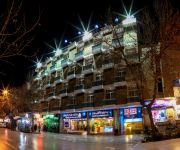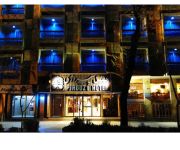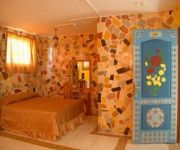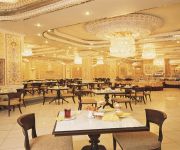Safety Score: 4,5 of 5.0 based on data from 9 authorites. Meaning please reconsider your need to travel to Iran.
Travel warnings are updated daily. Source: Travel Warning Iran. Last Update: 2024-08-13 08:21:03
Explore Maḩalleh-ye Khāneh-ye Eşfahān
The district Maḩalleh-ye Khāneh-ye Eşfahān of in Isfahan is located in Iran about 207 mi south of Tehran, the country's capital.
If you need a place to sleep, we compiled a list of available hotels close to the map centre further down the page.
Depending on your travel schedule, you might want to pay a visit to some of the following locations: Isfahan, Dowlatabad, Khomeyni Shahr, Shahin Shahr and Falavarjan. To further explore this place, just scroll down and browse the available info.
Local weather forecast
Todays Local Weather Conditions & Forecast: 15°C / 59 °F
| Morning Temperature | 11°C / 52 °F |
| Evening Temperature | 17°C / 63 °F |
| Night Temperature | 13°C / 56 °F |
| Chance of rainfall | 0% |
| Air Humidity | 37% |
| Air Pressure | 1017 hPa |
| Wind Speed | Light breeze with 3 km/h (2 mph) from West |
| Cloud Conditions | Clear sky, covering 6% of sky |
| General Conditions | Sky is clear |
Tuesday, 26th of November 2024
15°C (59 °F)
14°C (58 °F)
Sky is clear, light breeze, clear sky.
Wednesday, 27th of November 2024
15°C (59 °F)
14°C (56 °F)
Scattered clouds, gentle breeze.
Thursday, 28th of November 2024
12°C (53 °F)
9°C (48 °F)
Sky is clear, gentle breeze, clear sky.
Hotels and Places to Stay
INTERNATIONAL ISFAHAN PARSIAN KOWSAR HOTEL
Ali-Qapu Parsian Hotel
Piroozy Hotel
Azadi Hotel
Ebnesina Traditional Hotel
Tourist Isfahan
Isfahan Hotel
Zohreh
Melal Hotel
Videos from this area
These are videos related to the place based on their proximity to this place.
Visit of Esfahan - Isfahan - اصفهان - Ispahan (Iran / ایران )
Isfahan ou Esfahan (en persan : اصفهان, Esfahān) est une ville d'Iran, capitale de la province d'Isfahan. Le nom de la ville est aussi rendu sous la graphie Ispahan. Elle est située...
Ragazzi di Isfahan
Maggio 2014. Studenti festeggiano con scherzi vari un compleanno nella grandiosa piazza Naqsh-e jahàn (Oggi piazza dell'Imam).
Ashoura fast boat simulator Isfahan Iran شبيه ساز قايق تندروي عاشورا اصفهان ايران
April 20, 2014 (Persian calendar 1393/1/31) Ashoura عاشورا fast boat simulator designed and built in Isfahan اصفهان Iran.
کاخ عالي قاپـو;.aali ghapou isfahan;.
شما در این فیلم شاهد انتقال صدا از یک سمت ورودی های کاخ به سمت دیگر خواهید بود!
Menschen im Iran 2008 / people in Iran
um zu zeigen, dass es im Iran sympathische Menschen gibt - und nicht, wie von manchen Medien suggeriert, ausschließlich vermummte Fanatiker. Die mag es auch geben, die sind aber eine ...
Esfahan BIKE TOUR 2008
72 dní na kole po Íránu a Turecku. 72 days continuing solo bike tour around Iran and Turky.
Chehel Sotun - Esfahan, Iran
http://tripwow.tripadvisor.com/tripwow/ta-00be-7d84-b8ff?ytv2=1 - Created at TripWow by TravelPod Attractions (a TripAdvisorâ??¢ company) Chehel Sotun Esfahan Read more at: http://www.travelpod.
Videos provided by Youtube are under the copyright of their owners.
Attractions and noteworthy things
Distances are based on the centre of the city/town and sightseeing location. This list contains brief abstracts about monuments, holiday activities, national parcs, museums, organisations and more from the area as well as interesting facts about the region itself. Where available, you'll find the corresponding homepage. Otherwise the related wikipedia article.
Naqsh-e Jahan Square
Naqsh-e Jahan Square, known as Imam Square (میدان امام), formerly known as Shah Square (میدان شاه), is a square situated at the center of Isfahan city, Iran. Constructed between 1598 and 1629, it is now an important historical site, and one of UNESCO's World Heritage Sites. It is 160 meters wide by 508 meters long (an area of 89,600 m). The square is surrounded by buildings from the Safavid era. The Shah Mosque is situated on the south side of this square.
Chehel Sotoun
{{#invoke:Coordinates|coord}}{{#coordinates:32|39|27.12|N|51|40|20.69|E|region:IR_type:landmark |primary |name= }} UNESCO World Heritage SitePersian gardens Name as inscribed on the World Heritage List 250 pxType CulturalCriteria i, ii, iii, iv, viReference [http://whc. unesco. org/en/list/1372 1372]UNESCO region Asia and AustralasiaInscription historyInscription 2011 50x40pxThis article needs additional citations for verification.
Ali Qapu
Ālī Qāpū is a grand palace in Isfahan, Iran. It is located on the western side of the Naqsh-e Jahan Square opposite to Sheikh lotf allah mosque, and had been originally designed as a vast portal. It is forty-eight meters high and there are seven floors, each accessible by a difficult spiral staircase. In the sixth floor music room, deep circular niches are found in the walls, having not only aesthetic value, but also acoustic.
Naghsh-e-Jahan Stadium
The Naghsh-e-Jahan Stadium is a multi-purpose stadium in Isfahan, Iran. It is currently used for football matches. The stadium was built in 2003 and holds 45,000 in a three-tier configuration. It is currently used by Sepahan, an Iranian football team in Iran's Premier Football League. The first phase finished in 2003 and they have decided to finish the second phase which is the first floor of the stadium.
Imam Mosque Isfahan
Imam Mosque, is a mosque in Isfahan, Iran standing in south side of Naghsh-i Jahan Square. Built during the Safavid period, it is an excellent example of Islamic architecture of Iran, and regarded as one of the masterpieces of Persian Architecture. The Shah Mosque of Esfahan is one of the everlasting masterpieces of architecture in Iran. It is registered, along with the Naghsh-i Jahan Square, as a UNESCO World Heritage Site.
Sheikh Lotfollah Mosque
Sheikh Lutfollah Mosque is one of the architectural masterpieces of Safavid Iranian architecture, standing on the eastern side of Naghsh-i Jahan Square, Isfahan, Iran. Construction of the mosque started in 1603 and was finished in 1618. It was built by the chief architect Shaykh Bahai, during the reigh of Shah Abbas I of the Safavid dynasty. It is registered, along with the Naghsh-i Jahan Square, as a UNESCO World Heritage Site.
Isfahan University of Art
Isfahan University of Art is in Isfahan, Iran. It operated under the name of Farabi University before 1978, then it became a campus of the University of Art (based Art University in Tehran). It was separated and became independent in 1999. The university owns some of the greatest houses in Isfahan, mostly of the Safavid period.
Charbagh, Isfahan
Chahar Bagh Boulevard is a historical avenue in Isfahan constructed in the Safavid era of Iran. The avenue is the most historically famous in all of Persia. It connects north of city to south and is about 6 kilometers long. On the west side are situated the Gardens of the Vazirs, and on the east the Hasht Behesht and Chehel Sotoun gardens.
New Julfa
New Julfa is the Armenian quarter of Isfahan, Iran, located along the south bank of the river Zayandeh River. In 1606 it was established as an Armenian quarter by edict of Shah Abbas I, the influential shah from the Safavid dynasty. Over 150,000 Armenians were moved there from Julfa (also known as Jugha or Djugha) in Nakhichevan.
Siosepol
Si-o-se Pol {{#invoke:InfoboxImage|InfoboxImage|image=Si-o-se-Pol.
Hasht Behesht
Hasht Behesht, meaning "Eight Paradises" is a Safavid era palace in Isfahan. It was built in 1669 and is today protected by Iran's Cultural Heritage Organization. Of more than forty mansion which existed in Isfahan during the rule of Safavids, this is the only one left today.
Chahar Bagh School
Chahār Bāgh school (Madreseye Chahār Bāgh in Persian or مدرسه چهار باغ), also known as Shah school, is a 16-17th century cultural complex in Isfahan, Iran. The compound was built during Soltan Hossein, a Safavid king, to serve as a theological and clerical school to train those who were interested in such sciences. In order to finance the school, Soltan Hossein's mother had a large caravansary built nearby, the income of which went to the foundation.
Shahrestan bridge
Shahrestan bridge This is the oldest bridge on Zayandeh Rud. The foundations are from the 3rd to 7th century Sasanid era, but the top was renovated by the 10th century Deylamids and finally during the 11th century Seljuk period. However the architectural style is totally Sasanid. The bridge was built in two parabolic shapes. The vertical parabolic component means that the middle point of the bridge is the highest part.
Khaju Bridge
Khaju Bridge is arguably the finest bridge in the province of Isfahan, Iran. It was built by the Persian Safavid king, Shah Abbas II around 1650 C.E. , on the foundations of an older bridge. Serving as both a bridge, and a dam, it links the Khaju quarter on the north bank with the Zoroastrian quarter across the Zayandeh River. Although architecturally functioning as a bridge and a weir, it also served a primary function as a building and a place for public meetings.
Monar Jonban
The Monar Jonban (Shaking Minarets), or Menar-e-jomban, is a mosque located in Isfahan, in central Iran. Construction began in 14th century to cover the grave of Amu Abdollah Soqla. Its notable feature is that if one of the minarets is shaken, the other minaret will shake as well.
Fire temple of Isfahan
The Fire temple of Isfahan is a Sassanid-era archaeological complex located on a hill of the same name about eight kilometers west of city center of Isfahan, Iran. The hill, which rises about 210 meters above the surrounding plain, was previously called Maras or Marabin after a village near there, and it is by that name that the site is referred to by Arab historians.
Sarouyeh
Sarouyeh (سارویه) was a large library in ancient pre-Islamic Iran. The 10th century chronicler Ahmad ibn Rustah refers to it as "Sarough" (ساروق). The Fars Nameh of Ibn Balkhi calls it Haft Halkeh (هفت هلکه). The library, located near where the city of Isfahan is today, is written by some sources to have been from the era of Tahmuras, in ancient Iran. Majmal al-tawarikh also mentions the library.
Harati High School
Harati High School is located in Esfahan, Iran. The school is regarded as a well known landmark. It is located on Kamal Esmaeel Avenue (or Boulevard) between the Khadjoo and the 33 pol bridges.
Joui Bridge
Joui Bridge, also called the Choobi Bridge, is a bridge in Isfahan, Iran. It is one of Isfahan's oldest bridges and was built in 1665, during the Safavid era. The Joui Bridge is located between Khaju and Ferdowsi bridges. It is 147 meters long and 4 meters wide, with 21 arches. It was built during the reign of Shah Abbas II to irrigate and inter-relate the kings gardens on both sides of the river. The bridge and the two parlours within were for the exclusive use of the shah and his courtiers.
Abbasi Hotel
The Abbasi Hotel (formerly known as the Shah Abbas Hotel) is a hotel located in Isfahan, Iran. This complex was built at the time of king Sultan Husayn of Safavid about 300 years ago. It was built as a caravansary to provide lodging for passengers. The structure has been renovated since the 1950s to fight and prevent degradation. The 1974 film Ten Little Indians, starring Oliver Reed and Elke Sommer, was shot here.
Molla Abdollah School
Molla Abdollah School is located in the bazaar of Isfahan, Iran, and was a premises for prayer and theological studies by reputed clergy, including Mullah Abdollah Shooshtari, during the reign of Shah Abbas I of Persia.
Adab High School
Adab High School in Isfahan, Iran, was established in the early 20th century by British Anglican missionaries as an all-boys school. It was later converted to a secular school under the direction of Isa Sadiq (a man of letters and Minister of Education) and under the administration of Sayyid Yahya DowlatAbadi. Adab High School was the only all-boys high school in Isfahan with its own swimming pool and soccer field.
Constitution house of Isfahan
Constitution House of Isfahan, also known as Khaneh Mashrouteh or Khaneh Haj Aqa Nourrollah, is a historical edifice located next to the Great Naqsh-e Jahan Square, on Neshat Ave in Isfahan, Iran. During the years that led to the Persian Constitutional Revolution. Afterwards the house was used as a gathering place of the leaders, activists and sympathizers of the movement. The address of constitution house is No. 14 Neshat Ave.
Lonban mosque
Lonban, one of the oldest districts of Isfahan, is famous for its mosque. Its current structure is rebuilt in the contemporary era, but some of the plaster works and paintings are from the Safavid age. Some of the inscriptions on the portal are the art works of Mohammad Reza Emami. Besides there is an extraordinary wooden minbar which is one of the most exquisite artworks from the time of the Safavid dynasty.
Lonban
Lonban is one of the oldest districts of Isfahan. This district is famous for its mosque.






















